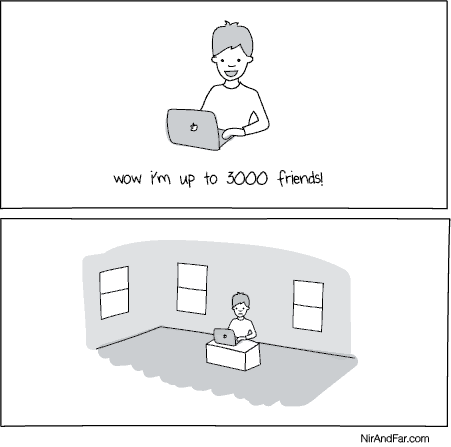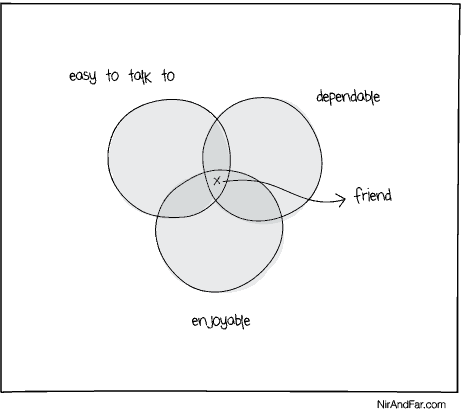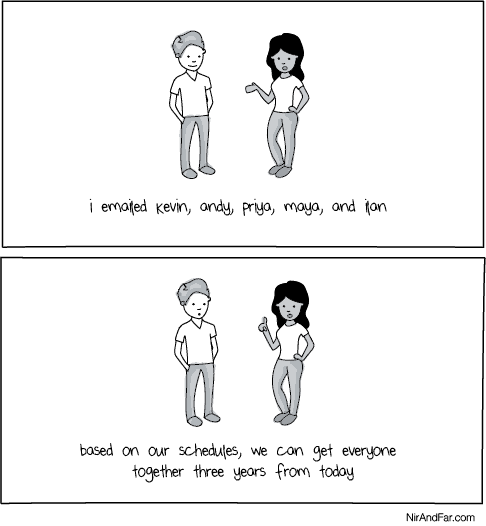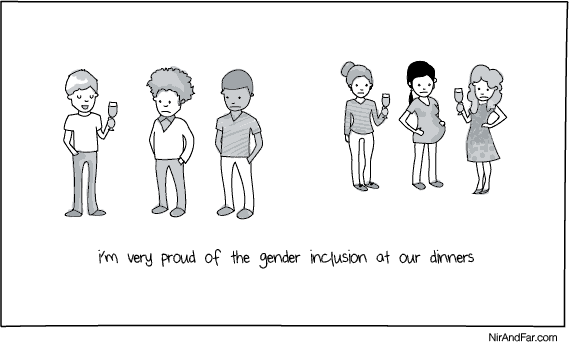When my wife and I moved to New York City in 2001, recently graduated from college and newly wed, we were eager to find friends. We knew nearly no one but were sure we’d soon find a fun-loving group like the 20- and 30-something New Yorkers who spontaneously dropped in on one another on TV shows like Seinfeld and Friends.
We hatched a plan. After moving into our Midtown Manhattan apartment, we invited all the neighbors over for drinks by placing Kinko’s-printed quarter-sheets into everyone’s mailboxes. Then, we waited for our versions of Chandler, Kramer, and Elaine to show up. But they didn’t. In fact, no one did. As the ice in the cooler melted and the guacamole browned, not a single person among 100 apartments stopped by. Not. One. Person.
Recalling that episode now, we sound embarrassingly naïve. We didn’t realize friendships in the real world worked nothing like the ones we had forged in our dormitories, let alone those we saw on television. Yet as it turns out, our desire to belong to a tight community was far from foolish.
Recent studies have shown a dearth of social interaction with people you care about and who care about you not only leads to loneliness, but is also linked to a range of harmful physical effects. In other words: A lack of close friendships may be hazardous to your health.
Dying for Friends
A 2010 meta-analysis reviewed 148 studies involving over 300,000 participants and concluded that having weak social ties was as harmful to health as being an alcoholic and twice as harmful as obesity. Julianne Holt-Lunstad, co-author of the analysis, told Reuters, “A lack of social relationships was equivalent to smoking up to 15 cigarettes a day.”
A more recent study, published in the Proceedings the National Academy of Sciences, found a biological response to loneliness that triggers disease. According to the researchers, social isolation sets off a cellular chain reaction that increases inflammation and suppresses the body’s immune response.
Perhaps the most compelling evidence that friendships affect longevity comes from the ongoing Harvard Study of Adult Development. Since 1938, researchers have been following 724 men, tracking their physical health as well as social habits. Robert Waldinger, the study’s current director, said in his recent TED Talk, “The clearest message that we get from this 75-year study is this: Good relationships keep us happier and healthier. Period.” Socially disconnected people are, according to Waldinger, “less happy, their health declines earlier in midlife, their brain functioning declines sooner, and they live shorter lives than people who are not lonely.”
Lest we think having 500 Facebook friends might offer some protection, Waldinger warns, “It’s not just the number of friends you have … it’s the quality of your close relationships that matters.”
So what makes for a quality friendship? William Rawlins, a professor of interpersonal communications at Ohio University who studies the way people interact over the course of their lives, told The Atlantic that satisfying friendships need three things: “Somebody to talk to, someone to depend on, and someone to enjoy.”
Finding someone to talk to, depend on, and enjoy comes naturally when we’re young. In college, for example, we build strong bonds when nearly everyone around us is also searching for connection. But as we grow into adulthood, the model for how to maintain our friendships isn’t clear. We graduate and go our separate ways, pursuing careers and starting lives miles apart from our best friends.
Suddenly work obligations and ambitions trump buddies and brewskis. It becomes impossible to be spontaneous without planning for weeks, if not months, in advance. Once children enter the picture, exhilarating nights on the town become exhausted nights on the couch.
Friendships Starve to Death
Unfortunately, the less time we invest in people, the easier it is to make do without them, until one day it becomes too awkward to reconnect. “Since we haven’t spoken for so long,” we think, “where would we even begin? If we were still close friends wouldn’t we have spoken more by now?”
This is how friendships die — they starve to death. But as the research reveals, by allowing those friendships to starve, we’re also malnourishing our bodies.
Case in point: Several months ago, I found myself in a funk. I now live in San Francisco and whenever someone asked, “How are you?” my reply was the standard Silicon Valley yuppie salute: “Good! Super busy!” Yet this wasn’t exactly true. I wasn’t good.
To put things in perspective, I wasn’t bad, either. Things were fine. By all measures, more than fine — I had a healthy family, a growing business, and interesting clients to work with. I’d recently published a book that became a Wall Street Journal best seller, and if my social media stats were to be believed, I had plenty of friends and followers.

And yet, the funk. I soon identified the problem: The more professional opportunities came my way, the more time I spent away from my real-life friends — the people I truly cared about. Maintaining friendships with people to talk to, depend on, and enjoy takes time.
As an undergraduate, I first heard the term “residual benefactor” in an economics class. A residual benefactor is the chump who gets whatever is left over when a company is liquidated — typically, not much. When we’re not careful, the people we care about often become residual benefactors: We leave them for last, giving them whatever bits of time are left over after we’ve attended to everything else.
The Solution, the Kibbutz
If the food of friendship is time together, how do we make the time to ensure we’re all fed? My friends and I have recently come across a way to keep each other close. It fits into our lifestyles despite busy schedules and a surfeit of children. We call it the “kibbutz.”
In Hebrew, the word means “gathering,” and for our gathering, four couples meet every two weeks to talk about one question — sort of like an interactive TED Talk over a picnic lunch. The question might range from a deep inquiry, like “What’s one thing your parents taught you that you want to pass on to your children?” to a lighter, more practical question, like “How do you disconnect from your iPhone on weekends?”
Having a topic helps in two ways. For one, it gets us past the small talk of sports and weather, and helps us open up about stuff that actually matters. Second, it prevents the gender split that happens when couples convene in groups — men in one corner, women in another. The question of the day gets us all talking together.
Consistency and Stiff-Arming the Kids
Every other week, rain or shine, the kibbutz is on our calendars — consistency is key. There’s no back-and-forth emailing to find a time. We always meet at the same place, and each couple brings their own food so there’s no prep or cleanup. If one couple can’t make it, no biggie, the others carry on the conversation.
What about the kids? In our group, kids are welcome, but they don’t run the show. Typically they play on their own, but if they interject, they’re given a stern response that sounds something like: “I’m having a conversation with my friends because my friends are important to me. You’re welcome to listen or join the conversation, but please don’t interrupt unless it’s an emergency.”
For our children’s sake, we want them to know that adult friendships matter. We don’t want them to have to rely on TV to figure out how adults interact. By watching us, our children see that being a good friend means listening when others have something to share, and not being distracted by anything else — including our cellphones, the football game, or even our own children (unless someone is bleeding).
The entire affair lasts about two hours, and I always leave the kibbutz with new ideas and insights. Most important, I feel closer to my friends. No, our group isn’t as funny or spontaneous as the pseudo-New Yorkers I grew up watching on TV. But it turns out that fun wasn’t what I was missing — it was authentic, caring friendships. Making time in my schedule to invest in my most important relationships finally snapped me out of my funk and provided the psychological nourishment I didn’t know I was missing.
Not only that, it turns out the time I spend with my friends is also an investment in my future health. Forget diets and the latest workout routines. The best medicine may be to gather your favorite people around a table and make a toast: “To friendship, and your health.”
Here’s the Gist:
- Studies show adult friendships have a significant impact on our happiness and well-being.
- Committing to my “kibbutz” has had the biggest impact on my happiness over the past year. Here’s how our group works, but the lessons can apply to any adult friendship:
- Book the time – Reserve time on your calendar for the foreseeable future so there’s no guesswork or scheduling headaches about when you’ll see each other again. Our group meets every two weeks.
- Go deep – Talking about a meaningful topic strengthens your bonds. Get past the shallow small talk. In our group, a different member brings the question of the day to each meeting.
- Don’t let kids derail you – Children benefit from seeing you model a healthy adult friendship. Tell the kids they can listen or participate, but they can’t interrupt unless it’s an emergency.
Nir’s Note: What do you think? How do you keep your friends close despite a busy schedule? Are you inspired to start a kibbutz? please share this essay if you found it interesting.
Illustrations by Liz Fosslien.
For more insights on using psychology to change behavior, join my free newsletter.
Related Articles
- Schedule Maker: a Google Sheet to Plan Your Week
- Habit Tracker Template in Google Sheets
- The Ultimate Core Values List: Your Guide to Personal Growth
- Timeboxing: Why It Works and How to Get Started in 2024
- An Illustrated Guide to the 4 Types of Liars
- Hyperbolic Discounting: Why You Make Terrible Life Choices
- Happiness Hack: This One Ritual Made Me Much Happier



